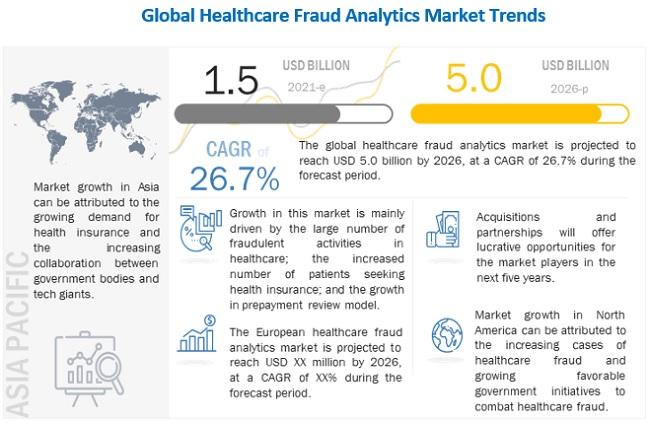A large number of fraudulent activities in healthcare, increasing number of patients seeking health insurance, high returns on investment, and the rising number of pharmacy claims-related frauds. However, the dearth of skilled personnel is expected to restrain the growth of this market.
According to a new market research report, “Healthcare Fraud Analytics Market by Solution Type (Descriptive, Predictive, Prescriptive), Application (Insurance Claim, Payment Integrity), Delivery (On-premise, Cloud), End User (Government, Employers, Payers), COVID-19 Impact – Global Forecast to 2026″, is projected to reach USD 5.0 billion by 2026 from USD 1.5 billion in 2021, at a CAGR of 26.7% during the forecast period.
The global healthcare fraud analytics market is facing a plethora of challenges. Travel bans and quarantines, halt of indoor/outdoor activities, temporary shutdown of business operations, supply demand fluctuations, stock market volatility, falling business assurance, and many uncertainties are somehow exerting a partial negative impact on the business dynamics.

The healthcare industry has been witnessing a number of cases of frauds, done by patients, doctors, physicians, and other medical specialists.
𝐆𝐞𝐭 𝐌𝐨𝐫𝐞 𝐈𝐧𝐬𝐢𝐠𝐡𝐭𝐬, 𝐆𝐫𝐚𝐛 𝐏𝐃𝐅 @ https://www.marketsandmarkets.com/pdfdownloadNew.asp?id=221837663
Many healthcare providers and specialists have been observed to be engaged in fraudulent activities, for the sake of profit. In the healthcare sector, fraudulent activities done by patients include the fraudulent procurement of sickness certificates, prescription fraud, and evasion of medical charges.
Emerging markets such as Asia promise significant growth in health insurance coverage, mainly due to increasing government initiatives, rising government and private investments for promoting medical insurance, and growing income levels. This growth is aided by the increasing affordability of health insurance for the middle class in this region and the rising awareness regarding the benefits of health insurance.
The healthcare industry is changing at an incredible rate, and one of the major contributors to this change is the increasing popularity of healthcare communication through social media.
Get Free Sample Pages @ https://www.marketsandmarkets.com/requestsampleNew.asp?id=221837663
This vast network of healthcare influencers, leaders, patients, providers, organizations, and governmental entities creates a massive amount of healthcare data on a regular basis. This data, if segregated, segmented, and analyzed in a meaningful way, can offer incredible value for improving treatment efficiencies and health outcomes.
The deployment of fraud analytics solutions is a time-consuming process. The process involves creating user interfaces, new databases, and predictive models; evaluating and deploying models, and monitoring their effectiveness. In this process, data analysts continuously run algorithms until they get the most effective predictive model.
Descriptive analytics forms the base for the effective application of predictive or prescriptive analytics. Hence, these analytics use the basics of descriptive analytics and integrate them with additional sources of data in order to produce meaningful insights.
